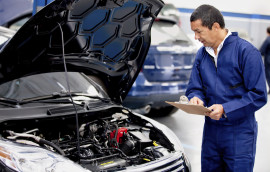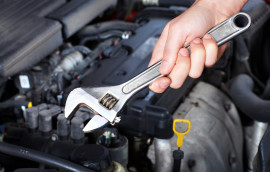Services
We work on all makes and models, call or email us today for an honest quote. We’re a family owned and family operated mechanic shop, we love what we do and love dealing with our customers directly unlike dealerships.

Vehicle Inspection

AUTO SERVICING & REPAIRS

Performance Upgrades
Ball Joint
Symptoms of Wear or Failure
- Suspension may make a knocking and/or squeaking noise over bumps
- Vehicle may wander
- Uneven tire wear
- Complete failure will result in the lower control arm becoming disconnected from the suspension knuckle, rendering the vehicle inoperable
Related Repair Advice
- The boot should be inspected during maintenance services to make sure it is not torn
- If possible, we recommend replacing ball joints as a set, especially on vehicles subject to heavy usage.
- In some cases, the control arm must be replaced in order to replace the ball joint
- Replacing the ball joints may affect the alignment’s settings. We recommend a four-wheel alignment when the ball joints are replaced.
Brakes
All drivers know that to stop a vehicle, you press the brake pedal. But how does the pedal make the vehicle stop? Brake systems slow and stop the vehicle by applying pressure to rotating brake discs and/or brake drums, which are attached to each wheel.
Disc Brakes
On vehicles with disc brakes (which is the vast majority), there is a metal disc called a rotor. When the brakes are applied, the brake pads are forced against the brake rotor, which will slow or stop your vehicle.
Drum Brakes
The brake drum fits over the brake shoes. When the brakes are applied, the brake shoes are forced against the inside of the brake drum. This causes the brake drum to stop rotating, which will slow or stop your vehicle.
Anti-Lock Brakes
The purpose of an anti-lock brake system (ABS) is to prevent the wheels from locking up or skidding during hard braking. If the brakes lock up, the vehicle takes longer to stop and the driver will have a difficult time steering and maintaining control of the vehicle.
Drivetrain
Automatic Transmission
The automatic transmission receives power (torque) created by the engine and sends it to the differential. Inside the transmission is a collection of gears that, based on vehicle speed and driving conditions, change automatically in order to keep the engine operating most efficiently.
Manual Transmission
The manual transmission receives the power (torque) created by the engine and sends it to the differential. During vehicle operation, the driver operates the clutch and moves the gear stick in order to select the best gear based on vehicle speed and driving conditions.
Engine
The engine is a mechanical device designed to convert chemical energy (fuel) into kinetic energy (motion), which powers your vehicle. Almost all vehicles (including hybrids) use internal combustion engines that burn fuel. In an internal combustion engine, air and fuel are ignited inside a cylinder and the pressure that is created forces pistons to move up and down. This rotates the crankshaft, which delivers power to the wheels via the drivetrain.
Electrical and Lights
Coming soon!
Engine
Almost all vehicles (including hybrids) use internal combustion engines that burn fuel. In an internal combustion engine, air and fuel are ignited inside a cylinder and the pressure that is created forces pistons to move up and down. This rotates the crankshaft, which delivers power to the wheels via the drivetrain.
Piston
A piston is a cylindrical piece of metal that moves up and down inside each cylinder, compressing the air-fuel mixture and capturing the force created by the combustion process. This force is then transferred to the crankshaft, via the connecting rod.
Crankshaft
The crankshaft is a long, steel shaft that transfers the up-and-down motion of the pistons and connecting rods into rotational motion.
Exhaust and Emissions
Exhaust System
Exhaust systems reduce the amount of noise produced by the engine and channel the high-temperature, poisonous exhaust gases from the engine by safely routing them under the vehicle. Then, through a system of manifolds, pipes, and sound-absorbing mufflers, the gases are released out of the back of the vehicle.
Emissions System
During normal vehicle operation, emissions are produced. While some of these emissions are harmless like water, heat, and oxygen, harmful byproducts—hydrocarbons (HCs), carbon monoxide (CO), and nitrogen oxide (NOx)—are also produced. One way the system reduces these harmful byproducts is by making the engine run more efficiently. The emissions system also recycles emissions back through the combustion process or converts them into harmless gases.
Emissions System
During normal vehicle operation, emissions are produced. While some of these emissions are harmless like water, heat, and oxygen, harmful byproducts—hydrocarbons (HCs), carbon monoxide (CO), and nitrogen oxide (NOx)—are also produced. One way the system reduces these harmful byproducts is by making the engine run more efficiently. The emissions system also recycles emissions back through the combustion process or converts them into harmless gases.
EVAP System
The evaporative control (EVAP) system captures any raw fuel evaporating from the fuel storage system. Under precise operating conditions dictated by engine temperature, speed, and load, the EVAP system purges these captured fuel vapors back into the combustion process.
EGR System
The exhaust gas recirculation (EGR) system recycles a small amount of exhaust gas from the exhaust system and mixes it with the intake manifold air going into the combustion chambers. The addition of this inert (or non-combustible) exhaust gas limits the peak combustion temperatures to a point before the formation of nitrogen oxide (NOx) is known to occur.
Secondary Air Injection System
Secondary air is used most commonly during the warmup cycle to help burn the rich air-to-fuel mixture needed to run a cold engine. Usually after two to three minutes, the catalytic converter is nearly at operational temperature, so the secondary air system shuts down. On some larger vehicles (e.g. trucks and SUVs), the secondary air system pumps air into exhaust manifolds during warmup and then directs the air into the catalytic converters during normal operation to help “burn off” the high fuel loads required to operate these heavy vehicles.
Heating and Air Conditioning
There are two parts to this system, one for heating and one for cooling. A variable speed fan is used to circulate the temperature-controlled air into the passenger compartment. The knobs and vents on your dashboard help you determine how much air is released into the cabin and where you want it directed.
Heating System
Your engine generates heat during the internal combustion process. Most of this heat is removed by the cooling system, but some of the excess heat can be harnessed and transferred to the compartment in order to keep passengers warm.
Air Conditioning
The AC system operates much like the heating system. Air is blown through a cold radiator behind the dashboard (the evaporator) and is cooled instead of heated. The cold air then blows into the passenger compartment through the vents on your dashboard.
Heater Core
The main component of a vehicle’s heating system is the heater core. Located behind the dashboard, the heater core is actually a small radiator. When you turn on the heater, a fan blows the air through the heater core where it is warmed.
Compressor
The air conditioning compressor pumps in refrigerant gas from the receiver/drier, compresses it, and sends it to the condenser.
Engine Cooling System
If the engine is too hot, it can overheat. If it’s too cold, the engine emits more pollutants and engine components prematurely wear out. If the cooling system fails to keep the engine at the right temperature, it can suffer significant damage and, in some cases, fail entirely.
Power Steering
Power Steering Pump
The power steering pump provides the hydraulic pressure necessary to operate the power steering system. The pressure is then converted into mechanical force in the steering gear or rack and pinion (depending on the vehicle). When the driver turns the steering wheel, the pressure helps push the wheels in the desired direction
Suspension System
A suspension system comes in two different designs—independent and solid (live) axle. Most cars use an independent suspension system, where each wheel moves up or down independently without affecting the other wheels. Some cars and most trucks use a solid axle suspension in the rear, where the axle moves up and down like a seesaw and the movement of one wheel causes a corresponding movement in the other wheel.
Vehicles with independent suspension systems offer a more comfortable ride and have better handling characteristics. Solid axle systems are stronger, less expensive to build, and have more load bearing capacity, but offer a rougher ride.
Steering System
The two most common types of steering systems are rack & pinion (used on most cars) and recirculating ball (used on trucks and utility vehicles). The rack & pinion system is similar to the independent suspension system in that it offers better control and handling. The recirculating ball system, like the solid axle system, is stronger and more robust, which is better suited for larger vehicles and trucks.
Strut/Shock
Shock absorbers dampen the shock the suspension receives when the vehicle is driven over rough or uneven road surfaces. A suspension strut—also referred to as a MacPherson strut—combines a shock absorber and coil spring into one assembly. This reduces the weight of the components and saves space, providing a lighter and more compact suspension system.
Rack & Pinion Steering Gear
Most cars use a rack & pinion steering system in which the steering wheel turns a steering shaft that is connected to a pinion gear. This gear moves a steering rack left and right. The rack has two arms attached to it called tie rods, which connect to the steering arm and help steer the wheels.
Power Steering
Those of us who have driven older cars remember how hard it was to steer before power steering came along. Power steering systems use hydraulic or electric power to exert extra force on the steering gear, which makes steering almost effortless for the driver.
Wheel Alignment
Why Should It Be Serviced?
- A vehicle with improper wheel alignment can cause premature tire wear.
- Improper alignment can cause the vehicle to drift out of your lane, causing unsafe driving conditions.
When Should It Be Serviced?
- If your vehicle is pulling or drifting to the left or right when driving
- You are experiencing abnormal tire wear
- Whenever a part on the suspension is replaced
Get In Touch
+1.613-247-7800
Location
2350 Stevenage Dr,
Ottawa, ON K1G 3W3,
Canada
Open Hours
Mon:9am – 6pm
Tue: 9am – 6pm
Wed: 9am – 6pm
Thur: 9am – 6pm
Fri: 9am – 6pm
Sat: 9am – 6pm
Sun: Closed
